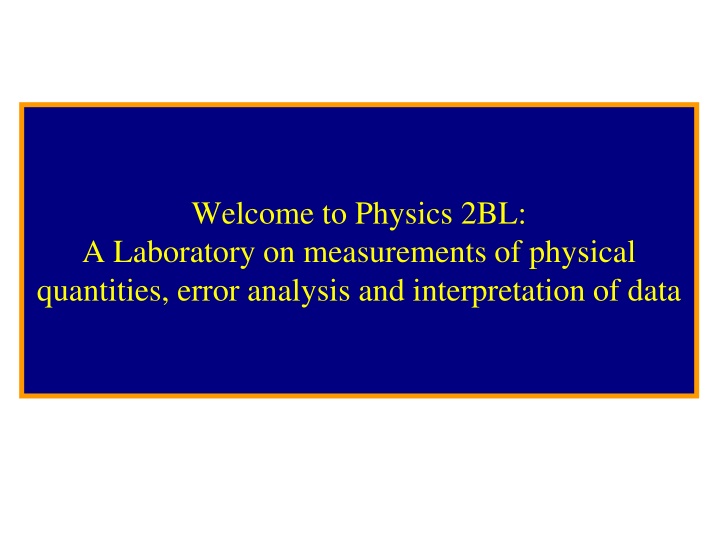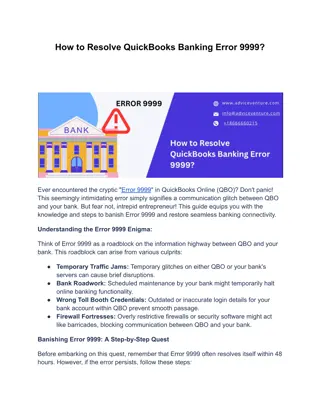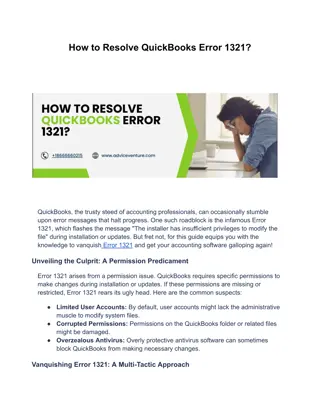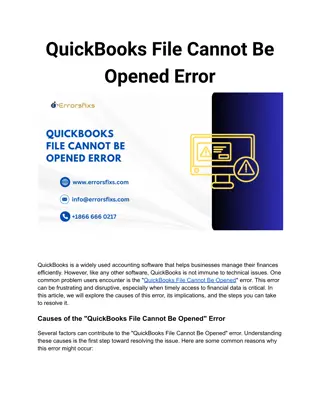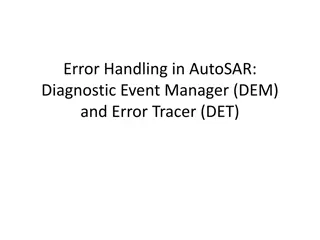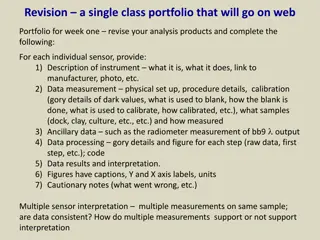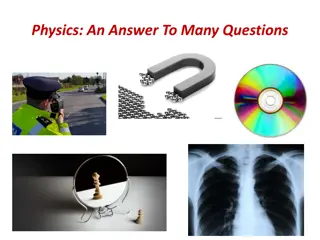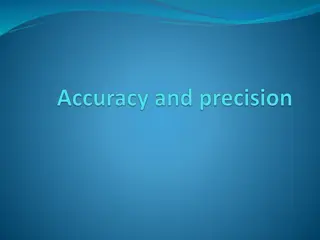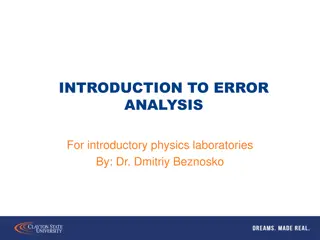Physics 2BL Laboratory: Measurements, Error Analysis & Data Interpretation
This Physics 2BL laboratory course focuses on measurements of physical quantities, error analysis, and interpretation of data. Students learn how scientists create models of natural phenomena and the practical aspects of conducting scientific experiments. Pre-requisites include Physics 2A, 4A or equivalent, concurrent enrollment in PHYS 2B/4C, and a basic understanding of calculus. The course covers mechanics, static electricity, accuracy assessment of measurements, and reporting scientific results. Students attend lectures, perform lab experiments, compute measurement uncertainties, estimate errors, and complete weekly homework. Labs are organized around different scientific methods and require pre-lab work. Interaction with lab TAs is essential for success in the course.
Download Presentation

Please find below an Image/Link to download the presentation.
The content on the website is provided AS IS for your information and personal use only. It may not be sold, licensed, or shared on other websites without obtaining consent from the author.If you encounter any issues during the download, it is possible that the publisher has removed the file from their server.
You are allowed to download the files provided on this website for personal or commercial use, subject to the condition that they are used lawfully. All files are the property of their respective owners.
The content on the website is provided AS IS for your information and personal use only. It may not be sold, licensed, or shared on other websites without obtaining consent from the author.
E N D
Presentation Transcript
Welcome to Physics 2BL: A Laboratory on measurements of physical quantities, error analysis and interpretation of data
Physics 2BL In this course you will: Learn how scientists form models of nature s phenomena How science is actually done (not the simplified version you read in textbooks) Learn how to assess the accuracy of measurements Extend your understanding of Mechanics & Static electricity through a hands-on exposure Learn how to report scientific results Pre-reqs: PHYS 2A, 4A or equivalent Concurrent enrollment in PHYS 2B/4C Basic course in calculus (Differentiation & Integration) 2
Physics 2BL: Spring 2013 Instructor Lab coordinator (LTAC) Lab location Course web page Vivek Sharma, 5561 MHA Tera Austrum, 2722 MHA 2722 MHA http://2bl.ucsd.edu all course related material will be posted there 2bl@physics.ucsd.edu Mondays, 10 -11 am Mondays, 2-4 pm Monday June 3rd during 2BL lecture hour (in RBC Auditorium) An Introduction to error analysis, 2nd edition by J.R Taylor. Available at UCSD bookstore 2BL team email address Instructor Office hour Lab coordinator office hours Final Exam Text book 3
Course Components & Your Tasks Attend all lectures in RBC Auditorium Provides context of each lab; Procedure for error analysis Read Lab descriptions (available at course website) before coming to assigned section of lab Perform 4 Lab experiments in MHA 2722 First lab starting Tue. April 9th (check your section time) Two 3 hour sessions (A & B) to complete each lab Learn how to compute measurement uncertainties Estimate measurement errors Propagate errors Read assigned chapters from the textbook Do weekly Homework based on textbook (self graded) 4
2BL Labs 3 hours per week the class is divided into several sections which do labs on different days & times of the week Organized around different aspects of scientific methods (observation, forming and testing models etc) Must read lab description (available at 2bl website) and do pre-lab home work before coming to the lab session Will be tested on your knowledge of the lab by a short quiz at the beginning of Session A of each lab Buy TWO quad-ruled notebook for lab report Record contact information for your lab TA; Listen to their instructions carefully; TA is the best friend you will have in this course ! 5
The Four 2BL Experiments (Labs) Determine the average density of the earth; Weigh the Earth, Measure its volume Measure simple things like lengths and times Learn to estimate and propagate errors Non-Destructive measurements of densities, inner structure of objects Absolute measurements vs. measurements of variability Measure moments of inertia Use repeated measurements to reduce random errors Construct and tune a shock absorber Adjust performance of a mechanical system Demonstrate critical damping of your shock absorber Measure the Coulomb force and calibrate a voltmeter Reduce systematic errors in a precise measurement 7
In-Lab Quizzes Held during the first 15 minutes of each A session Come to the lab promptly ! If you show up after the quiz has already been collected, you will receive a 0 All questions are directly from HW/pre-lab reading 2 pre-lab questions 2 HW questions Open book/open notes No Makeup quizzes or final exam 8
Lab Reports & Notebooks -2.5 points for every day that the report is late! Notebooks: Use a PEN & write clearly ! Report (10 pts per lab, 10% each on the following) Introduction (Objective, Essential Physics, Procedure) Methodology (Apparatus, Equations) Data/Observations (HOW did you estimate uncertainty?) Calculations/Error Analysis/Results Conclusions (dominant error source, discrepancy with published results, possible improvements) See 2bl web site (2bl.ucsd.edu) for detailed Lab notebook guidelines
Text Book & Homework Introduction to Error Analysis, by Taylor No information on experiments, but easy to read and contains very good info on how to handle data. Helpful with error analysis, conclusion writing Source of HW problems (similarly in finals) Many helpful examples! Brush up on Important 2A/4A physics you learnt. Review you Mechanics text book or consult Fundamentals of Physics, By Halliday, Resnick & Walker 7th Ed.
Homework Exercises Homework problems will be listed on 2bl web site Self graded: solutions will be posted on web site All problems are from Textbook (Taylor) They will help you understand and practice new concepts Solving them on your own will help you prepare for the quizzes & final!
Course Grading Quizzes Lab Reports Final Exam 20% 40% 40% Details: Quizzes (4) (graded out of 10 points) Quiz questions come directly from pre-lab & homework questions Lab Reports (4) Description of the experiment, diagram of apparatus, presentation of the data, error analysis, calculations, discussion and conclusions Final Exam Final exam will ask questions about the labs and will be similar to assigned homework 5% each Preparation is key for labs! Time is limited, so be prepared to perform the experiment If you run out of time, plan to attend LTAC office hours Mondays 2-4 pm 10% each 40%
Grading Policy Absolute grading scale Score > 95 % > 85 % > 70 % > 50 % > 40 % < 40 % Grade A+ A B C D F
How To Do Well In This Course Complete recommended readings before Monday lecture and definitely before your lab session 2bl site will have all information starting Tuesday 2nd Show up to all lectures and labs (ON TIME!) Before each lab: Review lecture slides Read experiment guidelines Answer all quiz questions within Do the homework Analyze data before the second lab session Ask questions during lecture & Lab ! For the final exam, feel free to make your own 2-page cheat sheet 14
Academic Integrity Please read the section on UCSD Policy on Integrity and Scholarship in: http://www.ucsd.edu/catalog/front/AcadRegu.html Acknowledge your partner s contributions (write their name on your lab report) Do not plagiarize your partner s work Collaboration in important Work on experiment in teams Lab report must be written individually! If in doubt, ask your lab TAs/LTAC/me 15
Know The Error Of Thy Ways (and learn how to report them correctly) 16
Measurement Error As Uncertainty Measurement uncertainty is inevitable ! Uncertainty (or error) in a measurement is not the same as a mistake Uncertainty results from: Limits of instruments finite spacing of markings on ruler Design of the measurement using stopwatch instead of a photogate Less-well defined quantities Such as composition of earth Report measurement of a quantity = x x 17
Uncertainty In Measuring Devices At other times you have to estimate it 18
Reporting Result Of Measurement: Significant Figures Experimental uncertainties should almost always be rounded to ONE significant figure! NOTE: The exception is when that sig fig is equal to 1, then keep two sig figs Measure l = 13.4 cm, estimate uncertainty to be cm l = 13.4 0.25 cm WRONG l = 13.4 0.3 cm RIGHT! Calculate g = 9.85 m/s2, uncertainty to be 0.095 m/s2 g = 9.85 0.1 cm WRONG g = 9.85 0.10 cm RIGHT! The last significant figure in the best estimate should be in the same decimal position as the last (or only) decimal position of the uncertainty Measure = 25.75 , estimate uncertainty to be 2 = 25.75 2 WRONG = 26 2 RIGHT! Be sure to follow the rules! You WILL miss points on lab reports, quizzes, & the final for not using proper sig figs ! 19
Measurement Accuracy & Precision Accuracy: Close to target ; Precision: Close to each other Distance from true value Spread between trials P r e c i s i o n 20 Accuracy
Types Of Measurement Errors Random Errors: Unavoidable Can be estimated by repeating measurements Can also be reduced by repeating measurements Systematic Errors: Harder to estimate, hard to reduce Can be due to calibration errors, neglecting small corrections, or procedural mistake 21
Statistical Analysis Of data How to arrive at the the best estimate and uncertainty for a collection of repeated measurements as opposed to a single measurement We use repeated measurements to Improve accuracy Estimate uncertaintyxbest dx How to determine xbest? How to estimate x ? 22
Repeated Measurements Make N measurements of the quantity x Best estimate the average or mean + + + = N xbest= x N ... 1 x x x = i = 1 2 x x N i N 1 = Standard deviation: uncertainty in any single measurement of x x x x i i x 1 ( ) 2 = x x x i 1 N best x = Uncertainty in mean (best guess) is the standard deviation of the mean best x x x = x x N 23
Propagating Errors In Expt 1, with a simple pendulum you will measure acceleration due to gravity g = 4p2l T2 If you measure Length Period What is the resulting uncertainty on g ? Need to propagate measurement errors =l dl =T dT Example : You measure xbest x Quantity q = q(x) What are qbest & qbest ? 24
General Formula For Error Propagation Single variable function q(x) q = q x Partial derivative: Differentiate w.r.t one variable while treating the others constant x For any function q(x, y, , z) 2 2 2 q xdx q ydy q zdz dq = + +...+ Add independent & random errors in quadrature (similar to Pythagorean Theorem) 25
Back To The Simple Pendulum Experiment Acceleration due to gravity g = 4p2/T2 Your data : T = 1.443 0.018s , = 0.520 0.003m Implies g = 9.8589 m/s2,dg =?? 2 2 q xdx q ydy Apply previous formula:dq = + g ldl =4p2 4p2 20.003m ( )= 0.0569m s2 T2dl = 1.443s ( ) ( ) T3dT =8p20.520m g TdT =8p2l ( )= -2AT-3 ( )= 0.246m s2Since 0.018s AT-2 1.443s ( ) 3 T So ( ) 2+ 0.246m s2 ( ) 2= 0.25m s2 0.3m s2 dg = 0.0569m s2 = 3 . 0 2 9 . 9 g m s Acceleration due to gravity:
Error Propagation : Some Examples = + q x y Sum and differences: = q x y ( ) x ( ) y 2 2 = + + q x If measurement errors on x & y are independent then q y Example: error on t = t1 t2 Measure t1 t1 t2 t2 d Dt ( dt1 ( ) ( ) )= 2+ dt2 2 27
Error Propagation : Fractional Error q = xy q = x y Then fractional error For Products and quotients: 2 2 dq q note : dq dx x dy y +dy = + dx q x y 28
Error Propagation: Summary Uncertainties in Counting: = q N (integer #) Uncertainties in Products and Ratios: Uncertainties in nth order polynomial: Uncertainties in Measured Value and exact constant: = q xy = q N = / q x y = n Uncertainties in Sums and Differences: q x = q Ax = + q x y 2 2 q x y = + q x = q x y = q x y n = q A x q x q x y + ( ) x ( ) y 2 2 = + + q x q x y 2 2 q y q q = + q x y General Rule: x y For independent random errors ( upper bound) q q + q x y 29 x y *always use radians when calculating the errors on trig functions
Schedule For This Week & Next This Week No labs this week Read chapters 1- 4 of the Taylor book (easy reading!) Work out Homework set #1 Next Week: Read Experiment #1 information posted at website Overview & guidelines Grading rubric Refresh your knowledge of physics involved Lecture will discuss experiment # 1 Labs will start Tuesday onwards, be prepared ! 30
Siginificant Figures The significant figures/digits (sig fig) of a number are those digits that carry meaning contributing to its precision. This includes all digits except: Certain leading and trailing zeros which are merely placeholders to indicate the scale of the number. Spurious digits introduced, for example, by calculations carried out to greater precision than that of the original data, or measurements reported to a greater precision than the equipment supports. Value 91 101.1203 0.00052 120.00 Significant digits 2 7 2 5 which ones 9 & 1 1, 0 , 1, 1, 2, 0 ,3 5, 2 1,2, 0 , 0 & 0 31
